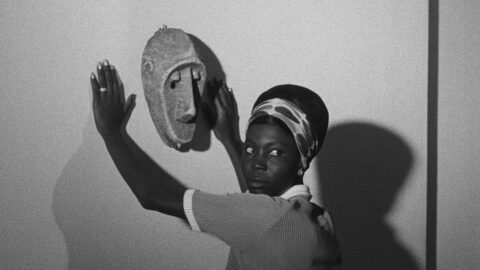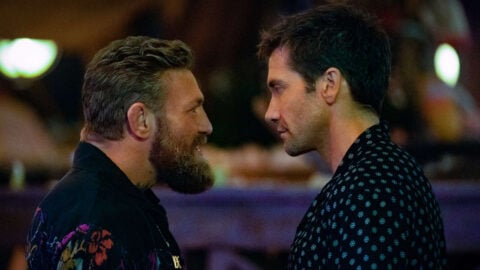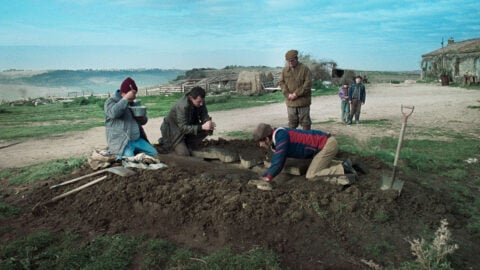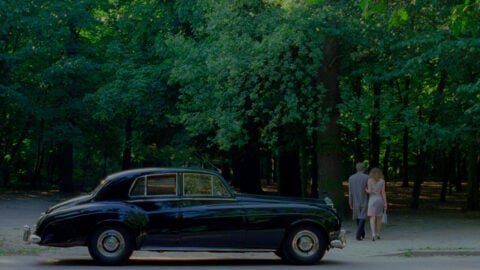Past Performance: Reviving Reenactment
This article appeared in the March 24, 2022 edition of The Film Comment Letter, our free weekly newsletter featuring original film criticism and writing. Sign up for the Letter here.
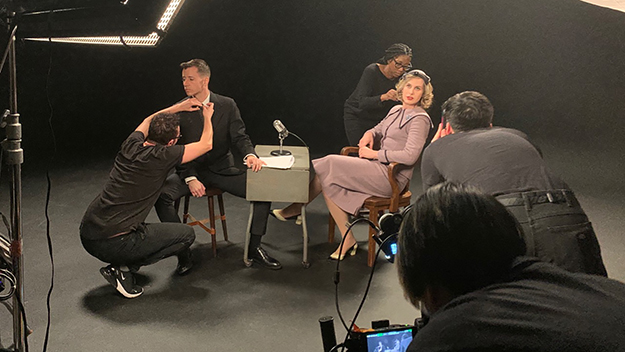
Framing Agnes (Chase Joynt, 2022)
Reenactment has seen an exciting resurgence in nonfiction cinema in the last decade or so. But for most of the second half of the 20th century, it was viewed with suspicion and marginalized as a practice. The reason, according to documentary scholar Stella Bruzzi, lies in the powerful, hegemonic sway once held by direct cinema. Famously, advocates of direct cinema believed that authenticity could only be achieved through neutral, fly-on-the-wall observation in which the camera becomes (as D.A. Pennebaker said) “just a window someone peeps through.” Such a view naturally abhorred devices such as reenactments, which were seen to betray reality through the application of artifice.
It wasn’t always this way. A century ago, Robert Flaherty notably used reconstructions in Nanook of the North (1922), a film considered foundational to the documentary canon. Filmmaker John Grierson, often described as the father of British documentary, defined the form as “the creative treatment of actuality” in a review of Flaherty’s Moana (1926), making ample room for reenactment as a perfectly valid formal choice. But after direct cinema stormed the nonfiction scene in the late 1950s, in Errol Morris’s strong words, it “set back documentary filmmaking 20 or 30 years.” The critical and commercial success of Morris’s The Thin Blue Line (1988) was pivotal in beginning the process of rehabilitating reenactment.
The present renewal of reenactment brings into the foreground two aspects central to nonfiction that were historically sidelined in discussions of direct cinema: performance and authorship. Outside of documentaries about public performers, such as musicians or actors, performance was often considered suspect, due to an overriding impulse to capture social actors simply “being themselves.” And authorship was frequently elided or pushed into the background because direct cinema positioned filmmakers as nonintrusive observers who aimed to transparently record an unmanipulated reality. A recent film that trains its focus on both of these aspects is the critically celebrated Procession (2021), directed by Robert Greene. Procession brings together six middle-aged men who were sexually abused as children by Catholic priests in the Kansas City area. Working with a drama therapist (Monica Phinney), they script, stage, perform, and film scenarios drawn from their childhood memories, with one child actor (Terrick Trobough) playing their younger selves.
Procession underscores the redemptive stakes of reenactment. In her recent book, In Person: Reenactment in Postwar and Contemporary Cinema, scholar Ivone Margulies invokes Italian neorealist Cesare Zavattini and his notion of “pedinamento” (shadowing or following, in this case reality), which he used to make a case for reenactment. To Zavattini, reenactment had a social and pedagogical function: it could be used to create “moral remakes.” Revisiting past actions through a self-aware and deliberate process cleared a space for reparation. Cinema was, for him, particularly suited to staging this process, thus making it a medium with special, restorative powers.
While it is evident from Procession that the reenactments (and the process leading up to them) were cathartic in some measure for the participants, Greene has also made it clear that the aim of the film was not to facilitate “healing,” which he considers an unrealistic goal. Instead, what the survivors were hoping to access was some semblance of meaning, some form of legibility for their experiences. Crucial to the film’s method was Greene’s ceding of creative authority to the six men, who became co-authors. In a rare gesture, the film’s credits list not only Greene but also the participant survivors under the heading “A Film By.”
Just as drama constitutes the primary means of working through trauma in Procession, the multilayered mobilization of theater in Clio Barnard’s The Arbor (2010) feels wholly apt given its subject: the British playwright Andrea Dunbar, and the lives of her family and children. Dunbar shot to fame at age 18 with an autobiographical play (“The Arbor”) set in a housing project, the Buttershaw estate in the northern British industrial town of Bradford, Yorkshire. Ravaged by poverty and addiction, Buttershaw represented a vivid instance of what deindustrialization and Thatcherism had wrought. Tragically, Dunbar was to die of a brain hemorrhage (linked to alcoholism) in 1990, when she was just 29.
Barnard’s film works in two major performative registers. First, there are street-theater performances of bits from Dunbar’s plays, staged in her actual neighborhood, amid furniture and props arranged on the grass. But more provocatively, there are interviews with Dunbar’s family (including her two daughters, Lisa and Lorraine, now adults) about their traumatic life experiences. In the film’s formal masterstroke, these interviews are visually staged but aurally real: actors lip-sync to audio recordings of Dunbar’s family members, following the practices of “verbatim theater,” a genre that draws from documentary source material such as recordings, interviews, and transcripts, and uses performers whose spoken words are scrupulously faithful to that material.
Because this device is clearly announced in the film’s opening titles, it disrupts the smooth illusionism that arises from the assumed unity of image and sound. We are simultaneously absorbed by the narrative accounts presented in the film and distanced by the knowledge of their constructedness. The interview subjects might be unseen (and played by professional actors), but their voices carry the searing charge of the real: they form the spine of the film.
Interviews and reenactments, albeit separate and distinct methods, share a common ground: that of performativity. It has long been acknowledged—at least since Erving Goffman’s classic sociological text, The Presentation of Self in Everyday Life (1958)—that performance is at the heart of not just theater but also life itself. All social actors, Goffman contended, craft performances in their interactions with others, thus guiding and shaping the impressions they make. Actor-director Sarah Polley’s Stories We Tell (2012), one of the most admired documentaries of the last decade, is built of both interviews and reenactments, each vying with the other in canny performativity.
The film’s subject is Polley’s mother Diane, who died when the director was a child. In her thirties, Polley discovered by accident that her biological father was a man with whom Diane had had an affair. As news of this shocking revelation spread among her family and friends, Polley noticed that numerous (and not always consistent) narratives about Diane were springing up in its wake. This proliferation of stories—and the primal social need to construct them—proved to be the impetus for the documentary.
In it, she interviews her brothers, sisters, and the man she had always assumed was her biological father, Michael (who is a professional actor); she also captures on camera an audio recording session at which he reads a long text which offers his own performative account of Diane, and his relationship with her. Finally, in the film’s most controversial nonfictional layer, Polley incorporates fabricated Super-8 home-movie footage in which Diane and the family are played by actors. This footage is so meticulously matched to the “actual” home-movie footage of her family also included in the film that many viewers felt duped—a response that surprised Polley, who assumed that the reenactments would easily be read as such. Polley has explained that her formal decisions flowed from her view that there was no way to directly access a singular “truth” about her personal and family history. Instead, this truth was multifaceted and could only emerge from an ensemble of “storytellers” (the word she used to characterize all the interlocutors in the film, including herself, who might also be considered co-authors).
If there is one recent work that dissects, with tireless self-reflexivity, the intertwined issues of nonfiction performance and authorship, it is surely Chase Joynt’s Framing Agnes (2022), winner of two major Sundance awards this year. Joynt and his research partner Kristen Schilt discovered the files of six trans people from the 1950s who gave interviews at UCLA to (cis, white, male) doctors as part of a study on transgender people (one of the patients gives the film its title). In this dizzyingly intricate documentary, Joynt and co-writer Morgan M. Page stage reenactments of the interviews in a 60 Minutes–style talk-show format, with Joynt—a trans man—himself playing the cis-male, Mike Wallace–like role.
Six well-known trans individuals—including Pose actress Angelica Ross; memoirist Max Wolf Valerio (The Testosterone Files); and blogger Stephen Ira, son of Annette Bening and Warren Beatty—were cast for the reenactments, and the lines they speak are drawn from the original interview transcripts. But these interviews form only the most prominent strand of the film’s thick, performative weave. In addition, we see: Joynt’s casual dressing-room conversations with each actor about the character they’re playing; formal interviews with the actors about their own lives; and fictional vignettes, set during the 1950s, about the subjects of the UCLA interviews. Finally, interspersed throughout are interview segments with trans historian Jules Gill-Peterson, who situates the film as both a work of trans history and an interrogation of the very processes of writing history.
Framing Agnes is bursting with ideas—even though it’s not in release yet, its makers have already given several thought-provoking interviews—and invites nearly limitless points of entry. Let me end with one that perfectly illustrates the tendency we have been exploring here: the powerful use of nonfiction reenactments to interrogate notions of authority and authorship. Framing Agnes can be seen as a response to how, historically, trans people have been forced to produce—for authority figures in two key institutions, the medical establishment and the media—narratives of their life in order to be accepted and get the care they need. But this narrativization has not always led to greater autonomy in (and greater authorship of) their own lives. The film offers a corrective intervention through its dense polyphony of trans voices. “Down with the solo author!” Joynt declaimed recently, expressing a wish to help create a collective work that is “smarter than its [individual] people.” It’s a call to arms that all cinema—especially the dominant institution of cis cinema—could stand to embrace.
Girish Shambu is on the faculty at Canisius College in Buffalo, New York. He writes for The Criterion Collection, is the author of The New Cinephilia, and is editor of Film Quarterly’s online column, Quorum.



